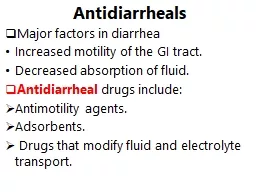

in diarrhea Increased motility of the GI tract Decreased absorption of fluid Antidiarrheal drugs include Antimotility agents Adsorbents Drugs that modify fluid and electrolyte transport ID: 935125
Download Presentation The PPT/PDF document "Antidiarrheals Major factors" is the property of its rightful owner. Permission is granted to download and print the materials on this web site for personal, non-commercial use only, and to display it on your personal computer provided you do not modify the materials and that you retain all copyright notices contained in the materials. By downloading content from our website, you accept the terms of this agreement.
Slide1
Antidiarrheals
Major factors
in diarrhea
Increased motility of the GI tract.
Decreased absorption of fluid.
Antidiarrheal
drugs include:
Antimotility
agents.
Adsorbents.
Drugs that modify fluid and electrolyte transport.
Slide2A. Antimotility agents
Two drugs that are widely used to control diarrhea are:
Diphenoxylate
[dye-fen-ox-see-late].
Loperamide
[
loe
-PER-ah-
mide
].
Both are analogs of
Meperidine
and have
opioid-like actions
on the gut.
They
activate
presynaptic opioid receptors
in the enteric nervous system to
inhibit acetylcholine release and decrease peristalsis
.
Slide3At the usual doses, they lack analgesic effects. Because these drugs can contribute to toxic
megacolon
, they should not be used in young children or in patients with severe colitis.
B. Adsorbents:
Adsorbent agents, such as
aluminum hydroxide and methylcellulose
[meth-ill-CELL-you-
lowse
], are used to control diarrhea.
These agents act by
adsorbing intestinal toxins or microorganisms
and/or by c
oating or protecting the intestinal mucosa
. They are
much less effective than
antimotility
agents
, and they can interfere with the
absorption of other drugs.
Slide4C. Agents that modify fluid and electrolyte transport
Bismuth subsalicylate
:
Used for
traveler’s diarrhea.
Decreases fluid secretion in the bowel.
Its action may be due to its
salicylate component as well as its coating action
.
Adverse effects
may include
black tongue and black stools
.
Slide5Slide6Laxatives
Purgatives
Laxatives are commonly used for constipation
to accelerate the movement of food through the GI tract.
These drugs can be classified on the basis of their mechanism of action.
Laxatives increase the potential for
loss of pharmacologic effect
of poorly absorbed, delayed-acting, and extended-release oral preparations
by accelerating their transit through the intestines
.
They may also cause
electrolyte imbalances
when used chronically.
Many of these drugs have a
risk of dependency
for the user.
Slide7Laxative weaker than purgatives
Purgatives :full cleaning of the GI use in: radiological, endoscopy
High doses of some laxatives (as) purgatives
Laxatives: remove constipation and the patient will be with normal bowel habit
Slide8Drugs Used to Treat constipation.
Slide9A. Irritants and Stimulants
Senna
:
This agent is a widely used
stimulant laxative
.
Its active ingredient is a group of
sennosides
, a natural complex of
anthraquinone
glycosides.
Taken orally,
senna
causes evacuation of the bowels within
8 to 10
hours.
It also causes
water and electrolyte secretion into
the bowel.
In
combination
products with a
docusate
containing stool softener, it is useful in treating
opioid-induced constipation
.
Bisacodyl
:
Available as
suppositories
and
enteric-coated tablets
,
bisacodyl
is
a potent stimulant
of the colon. It acts
directly on nerve fibers in the mucosa of the colon.
Slide103.
Castor oil
:
This agent is broken down in the small intestine to
ricinoleic
acid
, which is very irritating to the stomach and promptly
increases peristalsis
.
Pregnant patients
should avoid castor oil because it may
stimulate uterine contractions.
C. Saline and osmotic laxatives
Saline cathartics, such as
magnesium citrate
and
magnesium hydroxide
,
non-absorbable salts (anions and
cations
) that hold water in the intestine by
osmosis.
This distends the bowel, increasing intestinal activity and producing defecation in a
few hours
.
Electrolyte solutions
containing polyethylene glycol (PEG)
are used as
colonic lavage
solutions to prepare the gut for radiologic or endoscopic procedures.
Slide11PEG powder for solution is available as a
prescription
and also as an
over-the-counter
laxative and has been shown to cause less cramping and gas than other laxatives.
Lactulose
is a
semisynthetic
disaccharide sugar that acts as an osmotic laxative. It
cannot be
hydrolyzed by GI enzymes.
Oral doses reach the colon and are degraded by
colonic bacteria
into
lactic, formic, and acetic acids
.
This increases
osmotic pressure
, causing fluid accumulation, colon distension, soft stools, and defecation.
Lactulose
is also used for the
treatment of hepatic encephalopathy
, due to its ability to
reduce ammonia levels.
Slide12D. Stool softeners
(emollient laxatives or surfactants)
Surface-active agents
that become emulsified with the stool produce softer feces and ease passage.
These include
docusate
sodium
and
docusate
calcium
.
They may
take days
to become effective and are often used for
prophylaxis
rather than acute treatment.
Stool softeners
should not
be taken concomitantly with
mineral oil
because of the potential for
absorption of the mineral oil.
Slide13E. Lubricant laxatives:
Mineral oil and glycerin suppositories are lubricants and act by
facilitating the passage of hard stools.
Mineral oil
should be taken orally in an
upright position
to avoid its aspiration and potential for lipid or lipoid pneumonia.
F. Chloride channel activators
Lubiprostone
[loo-bee-PROS-tone], currently the only agent in this class, works by activating chloride channels to increase fluid secretion in the intestinal lumen.
This eases the passage of stools and causes little change in electrolyte balance.
Slide14Lubiprostone
is used in the treatment of
chronic constipation
, particularly because tolerance or
dependency has not been associated with this drug
.
Drug– drug interactions appear minimal
because
metabolism
occurs quickly in the
stomach and jejunum.